In pics: Livestock Demonstration Center in Idini, Mauritania
新華網(wǎng)
Editor: huaxia
2025-07-23 20:53:42
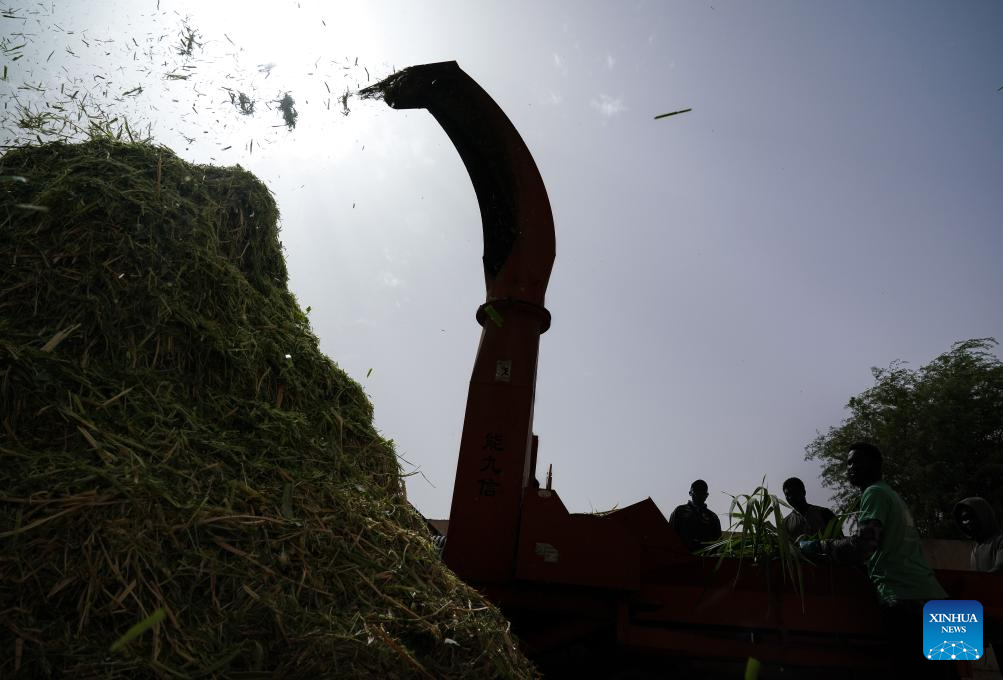
Herders chop Juncao at the Livestock Demonstration Center in Idini village, Mauritania, July 18, 2025. More than 80 percent of Mauritania's territory is covered by desert. Scorching heat, drought, poor soil quality, and violent sandstorms make it extremely difficult for plants to survive.
In 2017, China-backed technical cooperation for the Livestock Demonstration Center was officially launched in Idini.
Over the years, Chinese experts have successfully introduced alfalfa and expanded its large-scale cultivation, helping alleviate the local forage shortage. As a result, multiple varieties of forage plants have now taken root in the Sahara Desert. Between 2020 and 2024, the team developed about 20 hectares of desert land for forage plantation trials. (Xinhua/Han Xu)
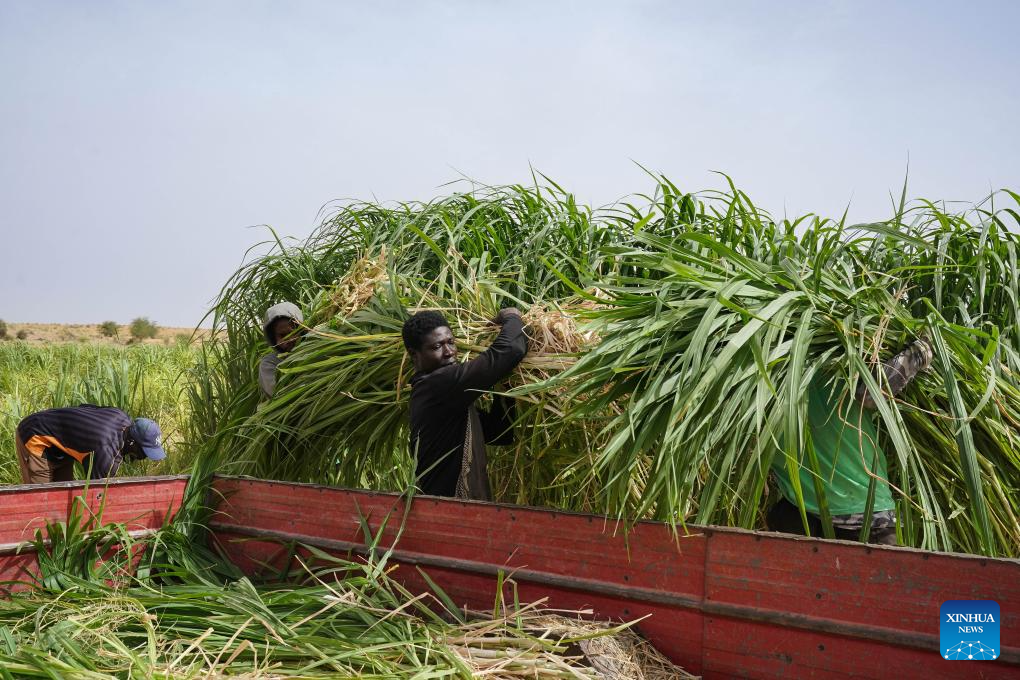
Herders harvest Juncao at the Livestock Demonstration Center in Idini village, Mauritania, July 18, 2025. More than 80 percent of Mauritania's territory is covered by desert. Scorching heat, drought, poor soil quality, and violent sandstorms make it extremely difficult for plants to survive.
In 2017, China-backed technical cooperation for the Livestock Demonstration Center was officially launched in Idini.
Over the years, Chinese experts have successfully introduced alfalfa and expanded its large-scale cultivation, helping alleviate the local forage shortage. As a result, multiple varieties of forage plants have now taken root in the Sahara Desert. Between 2020 and 2024, the team developed about 20 hectares of desert land for forage plantation trials. (Xinhua/Han Xu)
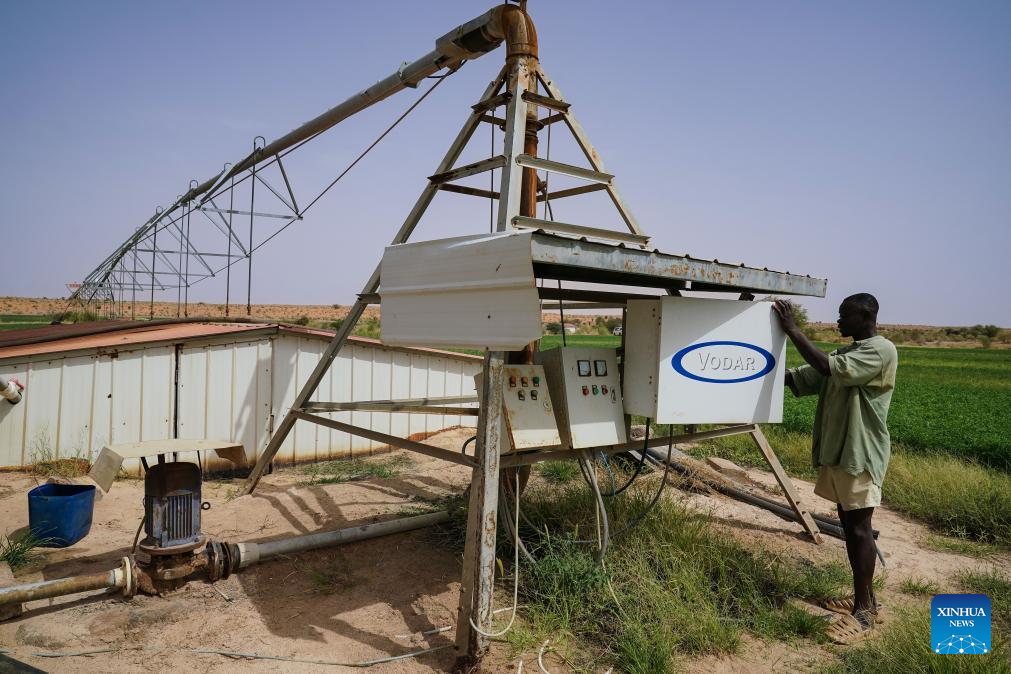
A herder operates a center-pivot irrigation system in an alfalfa field at the Livestock Demonstration Center in Idini village, Mauritania, July 18, 2025. More than 80 percent of Mauritania's territory is covered by desert. Scorching heat, drought, poor soil quality, and violent sandstorms make it extremely difficult for plants to survive.
In 2017, China-backed technical cooperation for the Livestock Demonstration Center was officially launched in Idini.
Over the years, Chinese experts have successfully introduced alfalfa and expanded its large-scale cultivation, helping alleviate the local forage shortage. As a result, multiple varieties of forage plants have now taken root in the Sahara Desert. Between 2020 and 2024, the team developed about 20 hectares of desert land for forage plantation trials. (Xinhua/Han Xu)
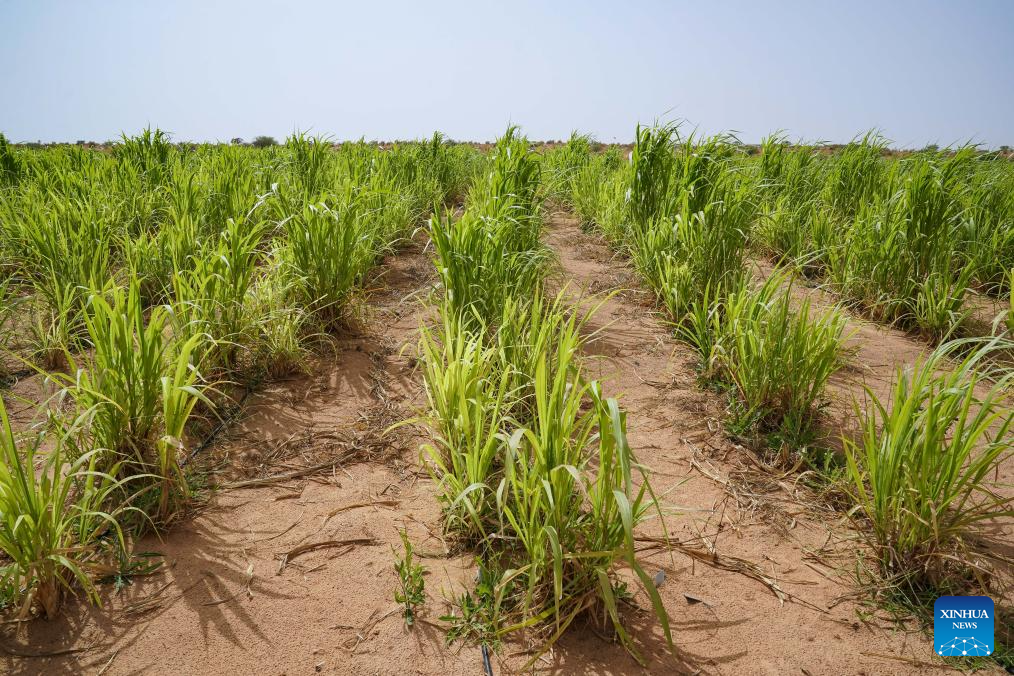
This photo taken on July 18, 2025 shows a Juncao field equipped with a drip irrigation system at the Livestock Demonstration Center in Idini village, Mauritania. More than 80 percent of Mauritania's territory is covered by desert. Scorching heat, drought, poor soil quality, and violent sandstorms make it extremely difficult for plants to survive.
In 2017, China-backed technical cooperation for the Livestock Demonstration Center was officially launched in Idini.
Over the years, Chinese experts have successfully introduced alfalfa and expanded its large-scale cultivation, helping alleviate the local forage shortage. As a result, multiple varieties of forage plants have now taken root in the Sahara Desert. Between 2020 and 2024, the team developed about 20 hectares of desert land for forage plantation trials. (Xinhua/Han Xu)
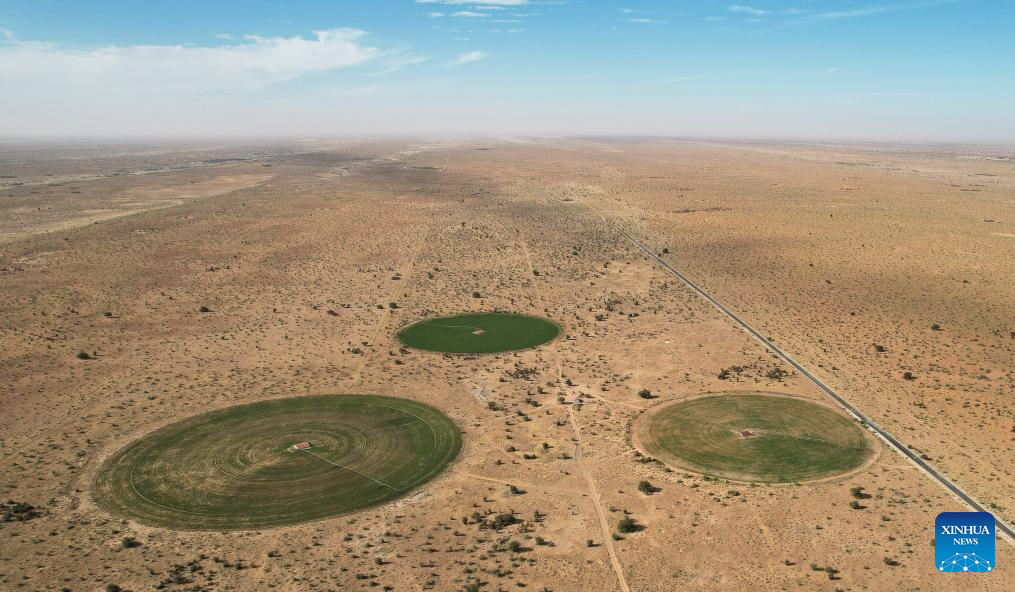
An aerial drone photo taken on Jan. 18, 2025 shows three alfalfa fields equipped with center-pivot irrigation systems at the Livestock Demonstration Center in Idini village, Mauritania. More than 80 percent of Mauritania's territory is covered by desert. Scorching heat, drought, poor soil quality, and violent sandstorms make it extremely difficult for plants to survive.
In 2017, China-backed technical cooperation for the Livestock Demonstration Center was officially launched in Idini.
Over the years, Chinese experts have successfully introduced alfalfa and expanded its large-scale cultivation, helping alleviate the local forage shortage. As a result, multiple varieties of forage plants have now taken root in the Sahara Desert. Between 2020 and 2024, the team developed about 20 hectares of desert land for forage plantation trials. (Xinhua/Si Yuan)
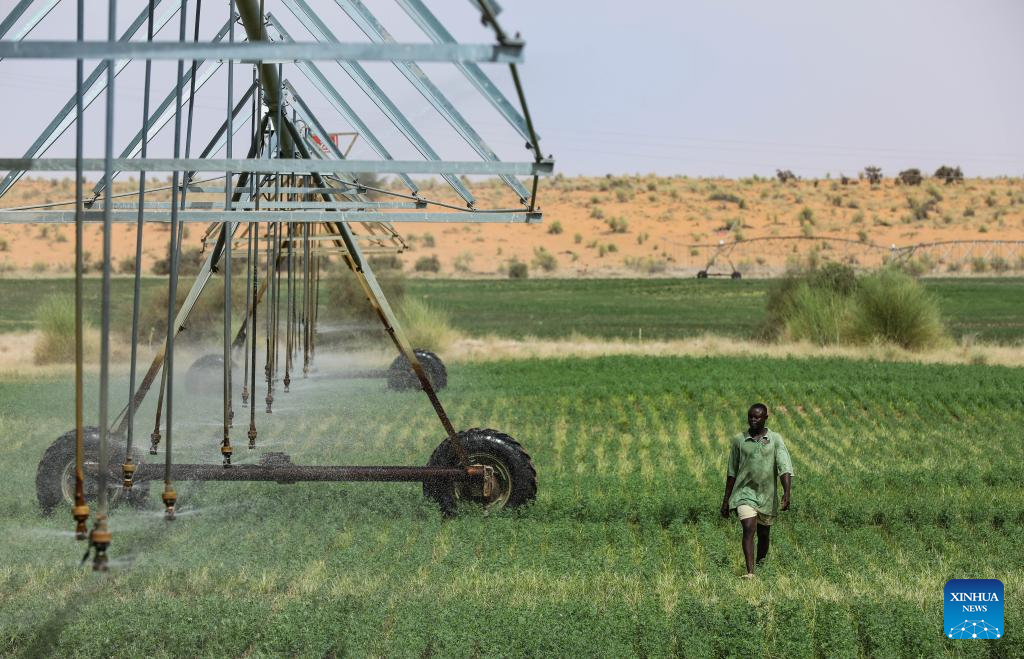
A herder checks the operation of a center-pivot irrigation system in an alfalfa field at the Livestock Demonstration Center in Idini village, Mauritania, July 18, 2025. More than 80 percent of Mauritania's territory is covered by desert. Scorching heat, drought, poor soil quality, and violent sandstorms make it extremely difficult for plants to survive.
In 2017, China-backed technical cooperation for the Livestock Demonstration Center was officially launched in Idini.
Over the years, Chinese experts have successfully introduced alfalfa and expanded its large-scale cultivation, helping alleviate the local forage shortage. As a result, multiple varieties of forage plants have now taken root in the Sahara Desert. Between 2020 and 2024, the team developed about 20 hectares of desert land for forage plantation trials. (Xinhua/Han Xu)
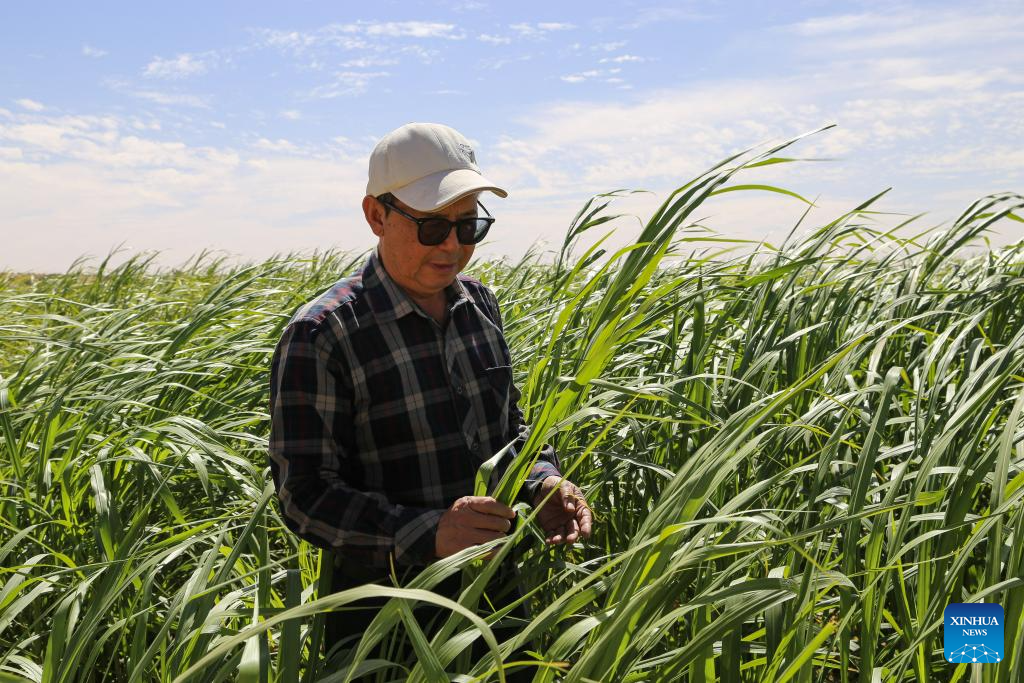
Zhang Hong'en, director of the Livestock Demonstration Center in Mauritania, checks the growth of Juncao grass in a test field at the Livestock Demonstration Center in Idini village, Mauritania, Jan. 18, 2025. More than 80 percent of Mauritania's territory is covered by desert. Scorching heat, drought, poor soil quality, and violent sandstorms make it extremely difficult for plants to survive.
In 2017, China-backed technical cooperation for the Livestock Demonstration Center was officially launched in Idini.
Over the years, Chinese experts have successfully introduced alfalfa and expanded its large-scale cultivation, helping alleviate the local forage shortage. As a result, multiple varieties of forage plants have now taken root in the Sahara Desert. Between 2020 and 2024, the team developed about 20 hectares of desert land for forage plantation trials. (Xinhua/Si Yuan)
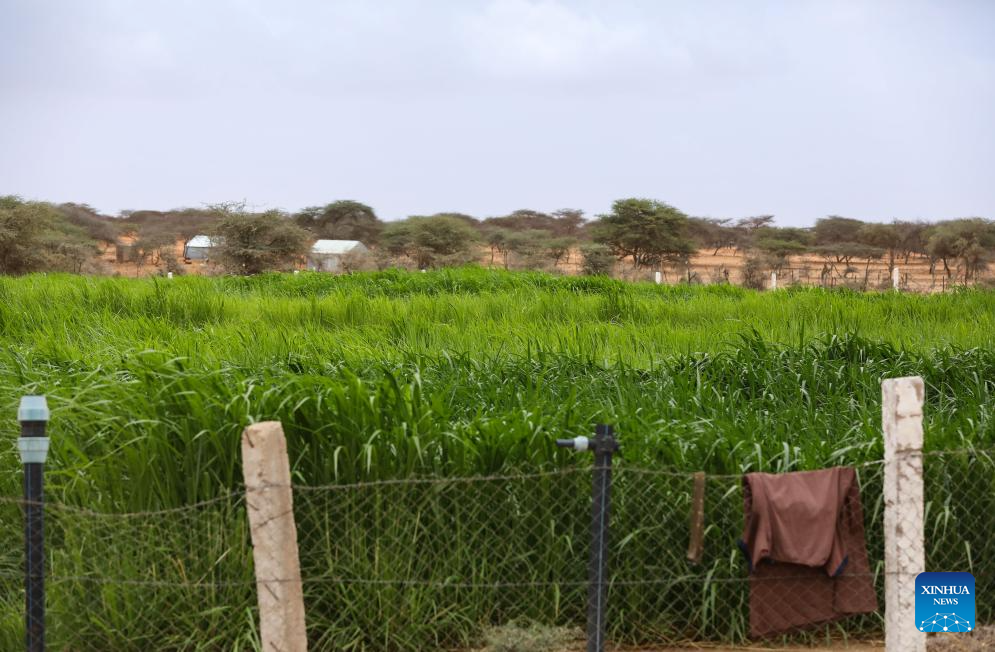
This photo taken on July 15, 2025 shows a Juncao field at a pasture, which was built and upgraded under the guidance of experts from the Livestock Technology Demonstration Center, in Tiguent, Mauritania. More than 80 percent of Mauritania's territory is covered by desert. Scorching heat, drought, poor soil quality, and violent sandstorms make it extremely difficult for plants to survive.
In 2017, China-backed technical cooperation for the Livestock Demonstration Center was officially launched in Idini.
Over the years, Chinese experts have successfully introduced alfalfa and expanded its large-scale cultivation, helping alleviate the local forage shortage. As a result, multiple varieties of forage plants have now taken root in the Sahara Desert. Between 2020 and 2024, the team developed about 20 hectares of desert land for forage plantation trials. (Xinhua/Han Xu)
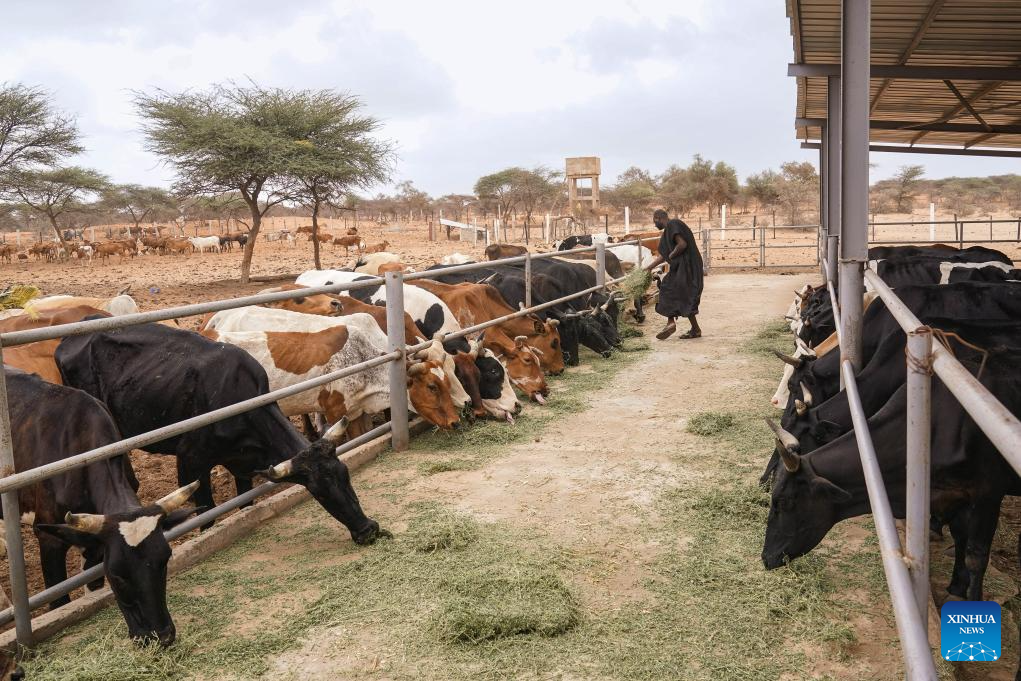
A herder feeds cattle with alfalfa fodder at a pasture, which was built and upgraded under the guidance of experts from the Livestock Technology Demonstration Center in Tiguent, Mauritania, July 15, 2025. More than 80 percent of Mauritania's territory is covered by desert. Scorching heat, drought, poor soil quality, and violent sandstorms make it extremely difficult for plants to survive.
In 2017, China-backed technical cooperation for the Livestock Demonstration Center was officially launched in Idini.
Over the years, Chinese experts have successfully introduced alfalfa and expanded its large-scale cultivation, helping alleviate the local forage shortage. As a result, multiple varieties of forage plants have now taken root in the Sahara Desert. Between 2020 and 2024, the team developed about 20 hectares of desert land for forage plantation trials. (Xinhua/Han Xu)
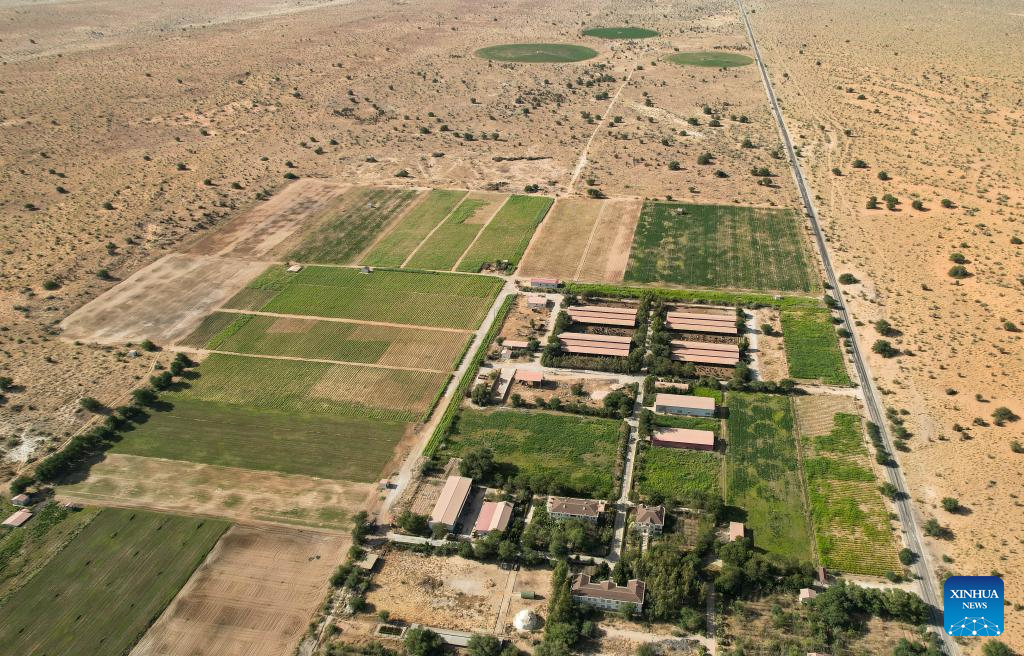
An aerial drone photo taken on Jan. 18, 2025 shows the Livestock Demonstration Center in Idini village, Mauritania. More than 80 percent of Mauritania's territory is covered by desert. Scorching heat, drought, poor soil quality, and violent sandstorms make it extremely difficult for plants to survive.
In 2017, China-backed technical cooperation for the Livestock Demonstration Center was officially launched in Idini.
Over the years, Chinese experts have successfully introduced alfalfa and expanded its large-scale cultivation, helping alleviate the local forage shortage. As a result, multiple varieties of forage plants have now taken root in the Sahara Desert. Between 2020 and 2024, the team developed about 20 hectares of desert land for forage plantation trials. (Xinhua/Si Yuan)
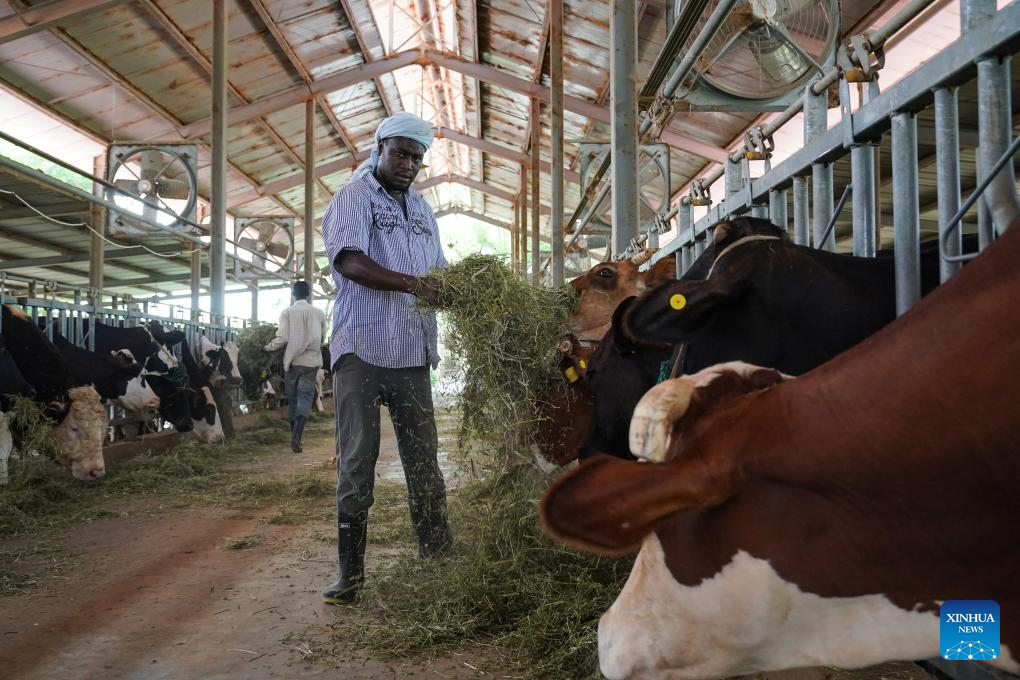
Herders feed alfalfa forage to cattle at the Livestock Demonstration Center in Idini village, Mauritania, July 18, 2025. More than 80 percent of Mauritania's territory is covered by desert. Scorching heat, drought, poor soil quality, and violent sandstorms make it extremely difficult for plants to survive.
In 2017, China-backed technical cooperation for the Livestock Demonstration Center was officially launched in Idini.
Over the years, Chinese experts have successfully introduced alfalfa and expanded its large-scale cultivation, helping alleviate the local forage shortage. As a result, multiple varieties of forage plants have now taken root in the Sahara Desert. Between 2020 and 2024, the team developed about 20 hectares of desert land for forage plantation trials. (Xinhua/Han Xu)
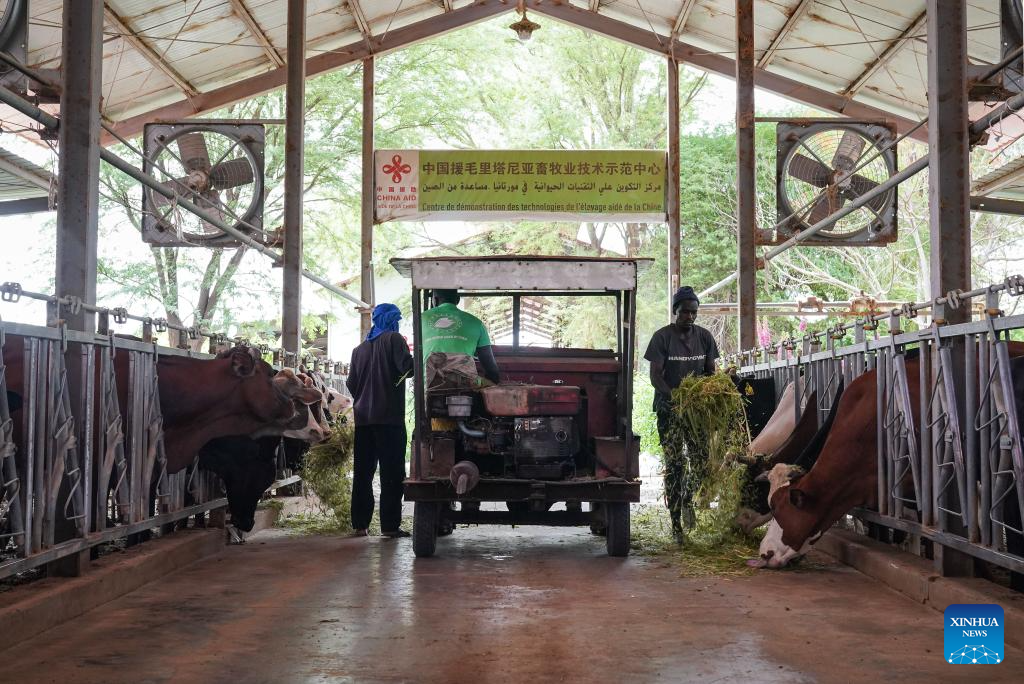
Herders feed Juncao forage to cattle at the Livestock Demonstration Center in Idini village, Mauritania, July 18, 2025. More than 80 percent of Mauritania's territory is covered by desert. Scorching heat, drought, poor soil quality, and violent sandstorms make it extremely difficult for plants to survive.
In 2017, China-backed technical cooperation for the Livestock Demonstration Center was officially launched in Idini.
Over the years, Chinese experts have successfully introduced alfalfa and expanded its large-scale cultivation, helping alleviate the local forage shortage. As a result, multiple varieties of forage plants have now taken root in the Sahara Desert. Between 2020 and 2024, the team developed about 20 hectares of desert land for forage plantation trials. (Xinhua/Han Xu)
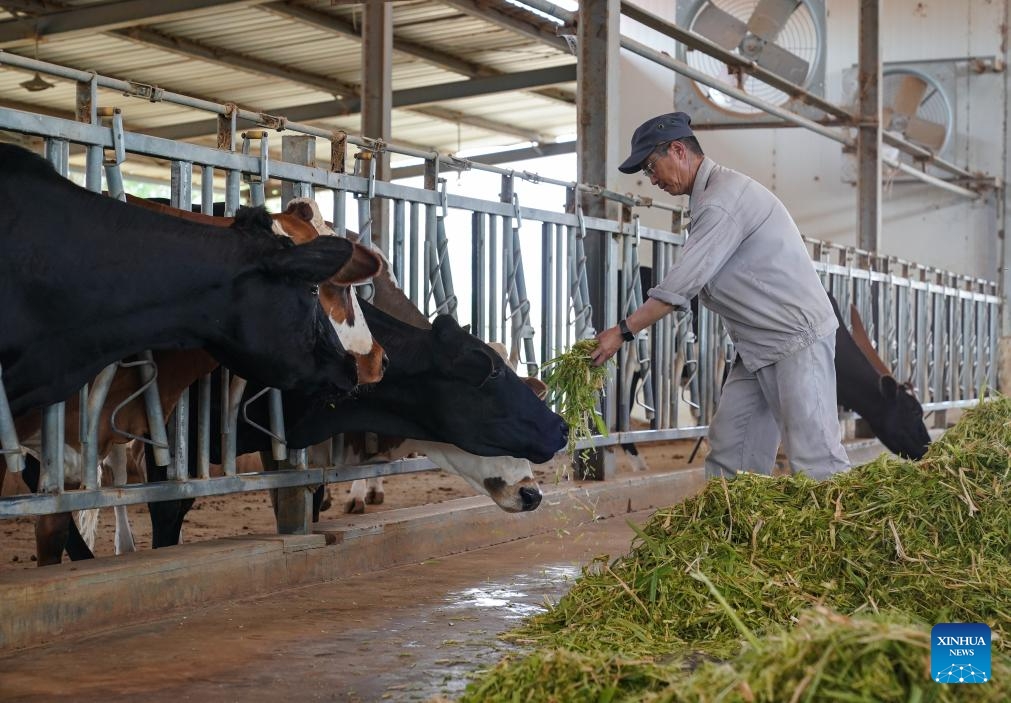
A Chinese expert in Mauritania checks on cattle feeding and growth conditions at the Livestock Demonstration Center in Idini Village, Mauritania, July 18, 2025. More than 80 percent of Mauritania's territory is covered by desert. Scorching heat, drought, poor soil quality, and violent sandstorms make it extremely difficult for plants to survive.
In 2017, China-backed technical cooperation for the Livestock Demonstration Center was officially launched in Idini.
Over the years, Chinese experts have successfully introduced alfalfa and expanded its large-scale cultivation, helping alleviate the local forage shortage. As a result, multiple varieties of forage plants have now taken root in the Sahara Desert. Between 2020 and 2024, the team developed about 20 hectares of desert land for forage plantation trials. (Xinhua/Han Xu)
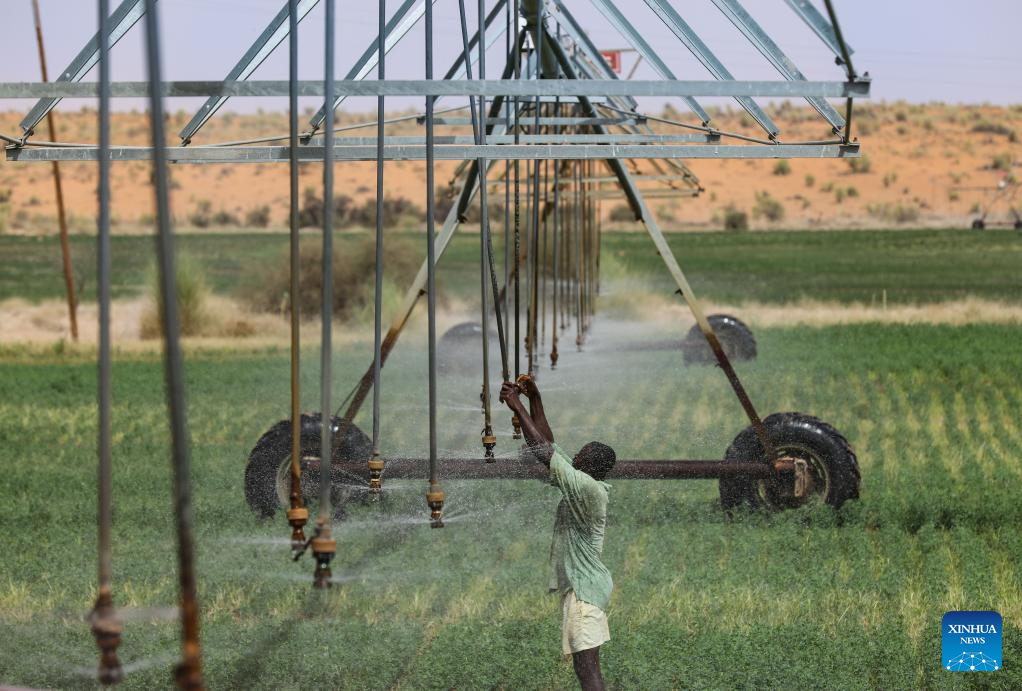
A herder checks on the operation of a center-pivot irrigation system in an alfalfa field at the Livestock Demonstration Center in Idini village, Mauritania, July 18, 2025. More than 80 percent of Mauritania's territory is covered by desert. Scorching heat, drought, poor soil quality, and violent sandstorms make it extremely difficult for plants to survive.
In 2017, China-backed technical cooperation for the Livestock Demonstration Center was officially launched in Idini.
Over the years, Chinese experts have successfully introduced alfalfa and expanded its large-scale cultivation, helping alleviate the local forage shortage. As a result, multiple varieties of forage plants have now taken root in the Sahara Desert. Between 2020 and 2024, the team developed about 20 hectares of desert land for forage plantation trials. (Xinhua/Han Xu)
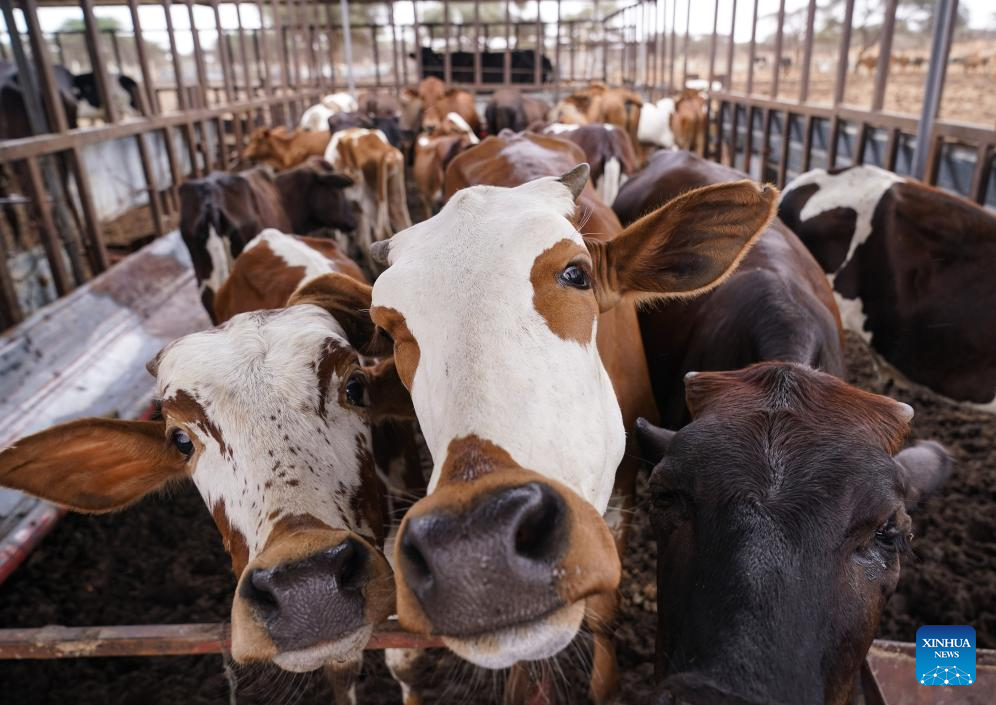
This photo taken on July 15, 2025 shows a herd of cattle at a pasture built and upgraded under the guidance of Chinese experts from the Livestock Demonstration Center in Tiguent, Mauritania. More than 80 percent of Mauritania's territory is covered by desert. Scorching heat, drought, poor soil quality, and violent sandstorms make it extremely difficult for plants to survive.
In 2017, China-backed technical cooperation for the Livestock Demonstration Center was officially launched in Idini.
Over the years, Chinese experts have successfully introduced alfalfa and expanded its large-scale cultivation, helping alleviate the local forage shortage. As a result, multiple varieties of forage plants have now taken root in the Sahara Desert. Between 2020 and 2024, the team developed about 20 hectares of desert land for forage plantation trials. (Xinhua/Han Xu)
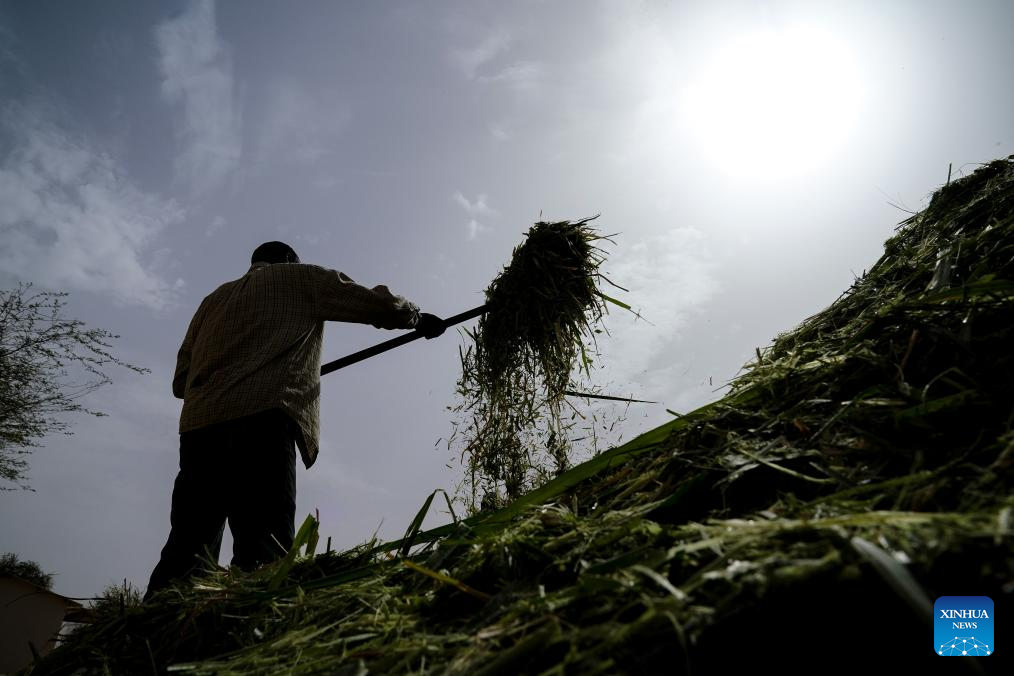
A herder processes chopped Juncao at the Livestock Demonstration Center in Idini Village, Mauritania, on July 18, 2025. More than 80 percent of Mauritania's territory is covered by desert. Scorching heat, drought, poor soil quality, and violent sandstorms make it extremely difficult for plants to survive.
In 2017, China-backed technical cooperation for the Livestock Demonstration Center was officially launched in Idini.
Over the years, Chinese experts have successfully introduced alfalfa and expanded its large-scale cultivation, helping alleviate the local forage shortage. As a result, multiple varieties of forage plants have now taken root in the Sahara Desert. Between 2020 and 2024, the team developed about 20 hectares of desert land for forage plantation trials. (Xinhua/Han Xu)



